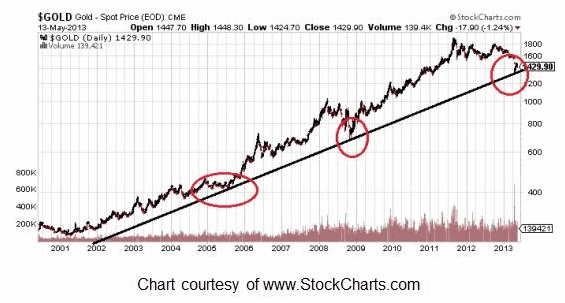Too many buyers as Central Bank of India restricts gold imports

Central Bank of India Restricts Gold Imports Data from the U.S. Commodity Futures Trading Commission showed that on May 7, there were 67,374 short contracts on gold bullion—speculators betting the yellow metal will go down in price. This was 6.4% higher than it was a week earlier. (Source: Bloomberg, May 13, 2013.)
According to EPFR Global, a firm that tracks money flows, for the week ending May 8, money managers fled from gold bullion and precious metal funds, withdrawing $1.27 billion. So far this year, they have withdrawn $20.8 billion—the largest amount since the firm started to track the data in 2000.
As bears continue to look for reasons to sell and investors pour out of gold, I see a brighter future for gold bullion ahead.
For the price of any investment to decline, there has to be some fundamental changes. Consider the decline in the key stock indices in 2008–2009. The reasons for the broad market sell-off were dismal earnings, a financial system on the verge of collapse, and anemic consumer demand.
But the fundamental reason for the rise in gold bullion prices hasn’t changed. There is still strong demand, and it’s increasing not just in U.S., but in the global economy.
In April, the trade deficit of India, the biggest consumer of precious metals, increased by more than 70% from March due to high imports of gold bullion and silver. The country imported $7.5 billion worth of precious metals in April, compared to $3.1 billion in the same year-ago period. (Source: MarketWatch, May 13, 2013.)
As a result of this pressure on the account deficit, the central bank of India put restrictions on gold bullion imports by banks in that country. In a statement, the Reserve Bank of India (RBI) said, “…to moderate the demand for gold for domestic use, it has been decided to restrict the import on consignment basis by banks, only to meet the genuine needs of exporters of gold jewellry.” (Source:
“Reserve Bank of India puts restrictions on gold imports by banks,” The Indian Express, May 13, 2013.)
Dear reader, take a look at the chart below of gold bullion prices stretching back to when the bull run began, and tell me if it looks like the uptrend has been broken.
$GOLD Gold-Spot Price stock market chart
Chart courtesy of www.StockCharts.com
The long-term trend is still in place, as it is evident that whenever prices touch the upward-moving trendline (the red circles in the chart above), gold bullion prices ended up going much higher.
Readers of Profit Confidential know I am bullish on gold bullion; my opinion remains the same. I consider the recent decline in gold bullion prices an opportunity. Michael’s Personal Notes:
This has caught some by surprise…
The U.S. government reported a budget surplus (money coming in was more than money going out) of $112.9 billion for the month of April. (Source: U.S. Department of the Treasury; Financial Management Services, May 10, 2013.)
It’s a surprise, because April’s surplus is the biggest monthly government budget surplus in five years.
But unfortunately, this trend will be very short-lived. The main reason the U.S. government was able to post a budget surplus in April was, obviously, the large amount of individual tax deposits during that month.
One month of budget surplus certainly doesn’t mean the U.S. government is back on its feet. On the contrary, the U.S. government has been posting a budget deficit for a long time now, and as a result, our national debt has skyrocketed to $17.0 trillion. It’s a major problem. So far in fiscal year 2013 (which began in October of 2012), the U.S. government has already run up a budget deficit of about $500 billion.
We are the most indebted nation in the global economy. Remember: when a government runs a budget deficit, it needs to borrow money to pay for its expenses.
And as the government continues to spend and post budget deficits, adding more to its national debt, there’s another set of troubles developing.
Consider the situation in Detroit, Michigan. The city is on the verge of defaulting on its obligations to its creditors because of its massive budget deficit. Detroit is expected to run out of cash, even though the state took control over the city’s finances. (Source: Bloomberg, May 13, 2013.)
Detroit is not the only city in the U.S. economy facing defaults; there are many others. There are states that have a significant amount of pension liabilities.
When cities run out of money, the states they are located in may be able to bail them out. But what happens when the states’ funds run dry? No doubt; they will go to the federal government for help. This phenomenon will force more spending and increase the budget deficit of the U.S. government, pushing the national debt even higher.
I am keeping a close eye on cities and states that are in trouble, because what happens next with them may send ripple effects through the economy.
Right now, the Federal Reserve is purchasing $45.0 billion worth of government bonds, but at the same time, it’s debating if its quantitative easing program should soon end. If the Fed does stop funding the U.S. government, a major buyer of U.S. bonds will be exiting the market. I wonder who will buy our bonds then.
What He Said:
“Over-built, over-speculated, over-financed and over-done. This is the Florida real estate market right now. For those looking to buy for personal use or investment, hold off! The best deals are yet to come. I continue with my prediction that the hard landing in the U.S. housing market, which is now affecting lenders, will have significant negative effects on the U.S. economy.” Michael Lombardi in Profit Confidential, April 3, 2007. Michael started talking
about and predicting the financial catastrophe we started experiencing in 2008 long before anyone else.
{{ commodity.name }}
{{ post.title }}
{{ post.date }}





Comments